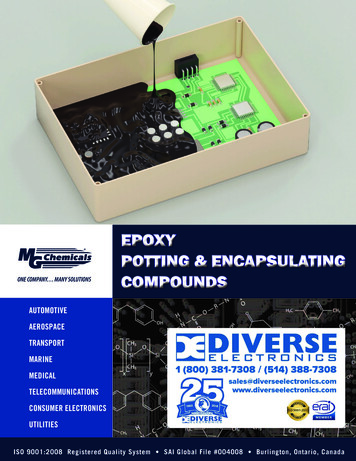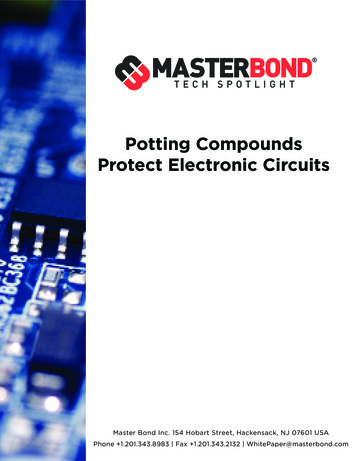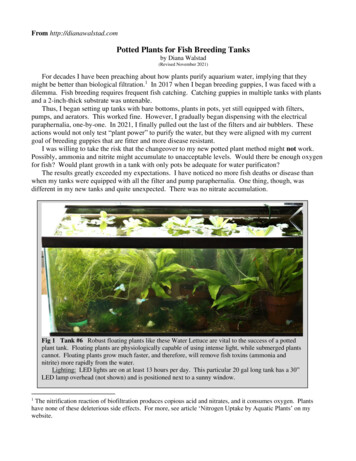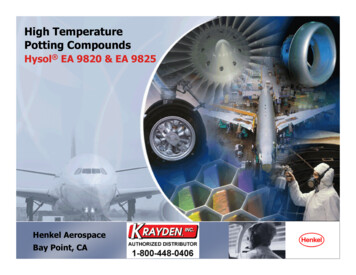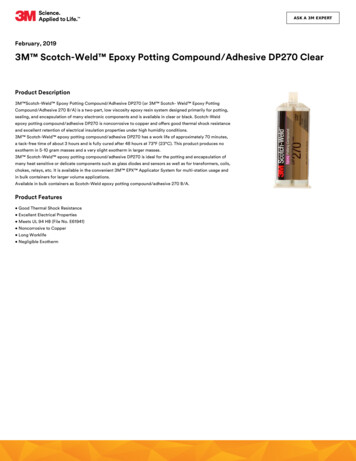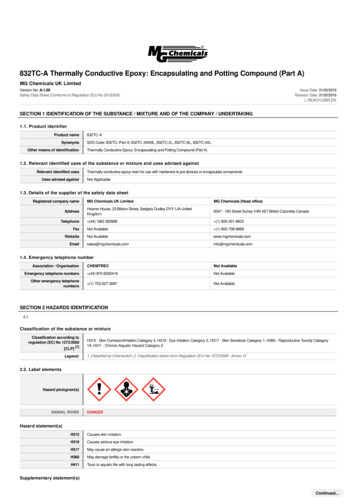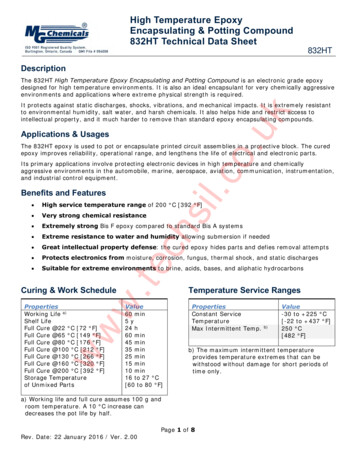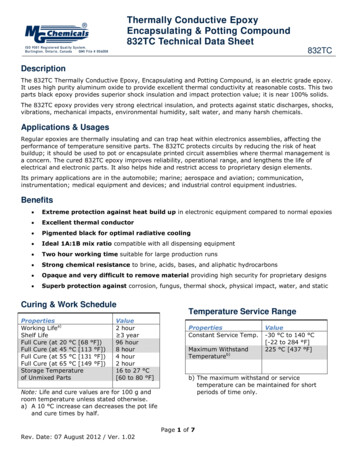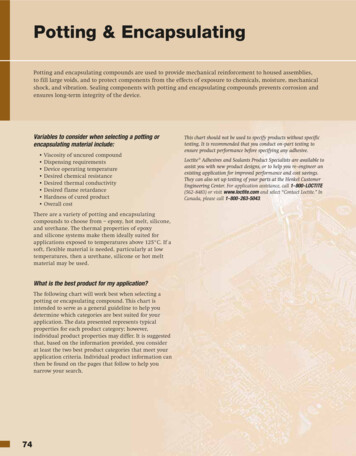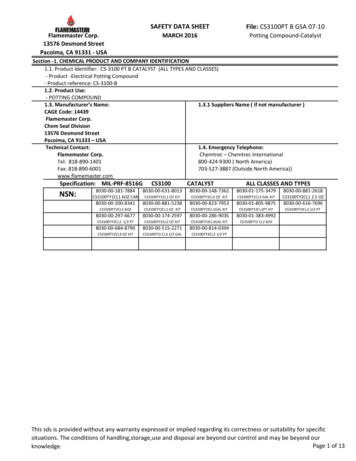
Transcription
Flamemaster Corp.13576 Desmond StreetPacoima, CA 91331 - USASAFETY DATA SHEETMARCH 2016File: CS3100PT B GSA 07-10Potting Compound-CatalystSection -1. CHEMICAL PRODUCT AND COMPANY IDENTIFICATION1.1. Product Identifier: CS-3100 PT B CATALYST (ALL TYPES AND CLASSES)- Product -Electrical Potting Compound- Product reference: CS-3100-B1.2. Product Use:- POTTING COMPOUND1.3. Manufacturer’s Name:1.3.1 Suppliers Name ( if not manufacturer )CAGE Code: 14439Flamemaster Corp.Chem Seal Division13576 Desmond StreetPacoima, CA 91333 – USATechnical Contact:1.4. Emergency Telephone:Flamemaster Corp.Chemtrec – Chemtrec InternationalTel: 818-890-1401800-424-9300 ( North America)Fax: 818-890-6001703-527-3887 (Outside North America))www.flamemaster.comSpecification: MIL-PRF-8516GNSN:8030-00-181-7884CS3100CATALYSTALL CLASSES AND TYPES8030-00-148-73628030-01-175-3479CS3100TY1CL1 QT KITCS3100TY1CL2 QT. KITCS3100TY1CL3 GAL 38030-01-805-9875CS3100TY2CL1 6OZCS3100TY2CL1 QT. KITCS3100TY2CL1GAL KITCS3100TY2CL1PT 58030-01-383-4992CS3100TY2 CL2 6OZCS3100TY1CL1 6OZ CAR8030-00-631-8013CS3100TY2CL2 1/2 PTCS3100TY2CL2 QT KITCS3100TY2CL2GAL 4CS3100TY2CL3 QT KITCS3100TY2 CL3 1/2 GALCS3100TY2CL2 1/2 PT8030-00-881-2618CS3100TY2CL1 2.5 OZ8030-00-616-7696CS3100TY2CL3 1/2 PTThis sds is provided without any warranty expressed or implied regarding its correctness or suitability for specificsituations. The conditions of handling,storage,use and disposal are beyond our control and may be beyond ourPage 1 of 13knowledge.
Section -2. HAZARD ( S ) IDENTIFICATIONACUTE TOXICITY (ORAL) 4, H302ACUTE TOXICITY (INHALATION) 4, H332SERIOUS EYE DAMAGE/EYE IRRITATION - Category 2, H319SKIN CORROSION/IRRITATION - Category 2, H315SKIN SENSITIZATION 1, H317CARCINOGENICITY 1B, H350CARCINOGENICITY (ORAL) 2, H351TOXIC TO REPRODUCTION (FERTILITY) 2, H361fREPRODUCTIVE TOXICITY 1A, H360SPECIFIC TARGET ORGAN TOXICITY (STOT) REPEATED EXPOSURE 2, H373ACUTE AQUATIC TOXICITY 1, H400CHRONIC AQUATIC TOXICITY 1, H410For A Complete List of H-Statements and Classifications See Section 16OSHA / HCS STATUS : THIS MATERIAL IS CONSIDERED HAZARDOUS BY THE OSHA HAZARD COMMUNICATION STANDARD(29 CFR 1910.1200)Human and Environmental Hazards:HAZARD STATEMENTS:Harmful by Inhalation and / or SwallowingIrritating to Eyes and SkinMay Cause An Allergic Skin ReactionMay Cause CancerMay Damage Fertility or the Unborn ChildMay Cause Damage to Organs Through Prolonged or Repeated ExposureVery Toxic to Aquatic Life with Long Lasting EffectsHAZARD PICTOGRAMS:SIGNAL WORD:DANGERThis sds is provided without any warranty expressed or implied regarding its correctness or suitability for specificsituations. The conditions of handling,storage,use and disposal are beyond our control and may be beyond ourPage 2 of 13knowledge.
Full text of P statements associated to this compound:P101 P102 P103: If medical advice is needed, have product container or label at hand. Keep out of reach of children.Read label before useP202: Do not handle until all safety precautions have been read and understoodP210: Keep away from heat/sparks/open flames and hot surfaces-No SmokingP240:Ground/bond container and receiving equipmentP261 P262 P263 P264:Avoid breathing dust/fumes/gas/mist/vapours/spray.Do not get in eyes , on skin, or onclothing. Avoid contact during pregnancy/while nursing. Wash thoroughly after handling.P270 P271 P273: Do not eat drink or smoke when using this product. Use only outdoors or in a well ventilated area.Avoid release to the environment.P281 P280: Use personal protective equipment as required. Wear protective gloves/ protective clothing/eye protection/face protectionP301 P310 P331: If swallowed: Immediately call a POISON CENTER or doctor/physician. Do not induce vomiting.P305 P351 P338 P315: If in eyes: Rinse cautiously with water for several minutes. Remove contact lenses,if presentand easy to do. Continue rinsing. Get immediate medical advice attention.P304 P340 P314: If inhaled: Remove victim to fresh air and keep at rest in a position comfortable for breathing.Get medical advice/attention if you feel unwellP342 P340 P315: If experiencing respiratory symptoms: Remove victim to fresh air and keep at rest in a positioncomfortable for breathing. Get immediate medical advice/attention.P302 P352: If on skin: Wash with plenty of soap and waterP306 P361: If on clothing: Remove/ take off immediately all contaminated clothingP402 P403 P404: Store in a dry place. Store in a well ventilated space. Store in a closed container.P233 P234 P235: Keep container tightly closed. Keep only in original container. Keep cool.HAZARDS NOT OTHERWISE CLASSIFIED: OXIDISING POTENTIAL: Contact with combustible material may result in fire.Keep away from combustible materials. This material increases the risk of fire and may aid in combustion.Other Hazards that do not result in classification:Prolonged or repeated exposure may dry skin and / or cause irritationSection -3. COMPOSITION / INFORMATION ON INGREDIENTSChemical family : Mixture of organic compoundsFor the hazards of the composition, ( SDS see Section 2).LEAD DIOXIDECAS#1309-60-0EC#215-174-570-80% by weightOSHA HAZARDS: OXIDIZER, CARCINOGEN, TARGET ORGAN EFFECT, TOXIC BY INHALATION, HARMFUL BY INGESTIONTERATOGEN,REPRODUCTIVE HAZARDTARGET ORGANS: FEMALE REPRODUCTIVE SYSTEM, MALE REPRODUCTIVE SYSTEM, NERVES, BLOOD, KIDNEYGHS CLASSIFICATION: LEAD DIOXIDEOXIDIZING SOLIDS (CATEGORY 3), H272ACUTE TOXICITY, ORAL (CATEGORY 4), H302ACUTE TOXICITY, INHALATION (CATEGORY 4),H332CARCINOGENICITY (CATEGORY 1B), H350REPRODUCTIVE TOXICITY (CATEGORY 1A), H360SPECIFIC TARGET ORGAN TOXICITY-REPEATED EXPOSURE (CATEGORY 2), H3ACUTE AQUATIC TOXICITY (CATEGORY 1), H400CHRONIC AQUATIC TOXICITY (CATEGORY 1), H410This sds is provided without any warranty expressed or implied regarding its correctness or suitability for specificsituations. The conditions of handling,storage,use and disposal are beyond our control and may be beyond ourPage 3 of 13knowledge.
LEAD OXIDECAS#1317-36-8EC# 215-267-0 10% by weightOSHA HAZARDS: CARCINOGEN, TARGET ORGAN EFFECT, TOXIC BY INHALATION,HARMFUL BY INGESTIONTERATOGEN, REPRODUCTIVE HAZARDTARGET ORGANS: BLOOD, KIDNEY, NERVES, GASTROINTESTINAL TRACT, REPRODUCTIVE SYSTEMGHS CLASSIFICATION: LEAD OXIDEACUTE TOXICITY, INHALATION (CATEGORY 4), H332ACUTE TOXICITY, ORAL (CATEGORY 4), H302CARCINOGENICITY, (ORAL), (CATEGORY 2), H351REPRODUCTIVE TOXICITY (CATEGORY 1A), H360SPECIFIC TARGET ORGAN TOXICITY-REPEATED EXPOSURE (CATEGORY 2), H373ACUTE AQUATIC TOXICITY (CATEGORY 1), H400CHRONIC AQUATIC TOXICITY (CATEGORY 1),H410Lead Oxide is included in the Candidate List of Substances of Very High Concern (SVHC) according toRegulation (EC) No. 1907/2006 (REACH)CHEMICAL NAME: TERPHENYL, HYDROGENATEDAQUATIC CHRONIC (CATEGORY 4) - H413CHEMICAL NAME: TERPHENYLAQUATIC ACUTE (CATEGORY 1) - H400AQUATIC CHRONIC (CATEGORY 1) - H410CAS# 61788-32-7CAS# 26140-60-3CHEMICAL NAME: POLYPHENYL, QUATER AND HIGHEREC# 262-967-7EC# 247-477-3CAS# 68956-74-1 50% by weight 10% by weight 10% by weightSection -4. FIRST-AID MEASURESGeneral: When in doubt or symptoms persist, seek medical attention. Have Safety Data Sheet informationavailable. Never give anything by mouth to an unconscious person.Inhalation: Remove to fresh air, if breathing has stopped, administer artificial respiration. Give nothing by mouth,seek immediate medical attention.Eye contact: Check for and remove any contact lenses. Irrigate with clean, fresh water for at least 15 minutes,holding the eyelids apart. Seek immediate medical attention.Skin contact: Remove contaminated clothing. Wash skin thoroughly with soap and water or use recognized skincleaners. Do NOT use aromatic solvents, thinners or petroleum products.Ingestion: If accidentally swallowed obtain immediate medical attention. Keep at rest. Do NOT induce vomiting. Nevergive anything by mouth to an unconscious person.This sds is provided without any warranty expressed or implied regarding its correctness or suitability for specificsituations. The conditions of handling,storage,use and disposal are beyond our control and may be beyond ourPage 4 of 13knowledge.
Section -5. FIRE-FIGHTING MEASURESExtinguishing agentsRecommended: Universal resistant foam, CO2, water, powder.Agents to avoid: None knownAttentionFire will produce dense black smoke. Exposure to decomposition products may cause a Health Hazard. Fire fighters shouldwear self-contained breathing apparatus.Water mist may be used to cool closed containers to prevent pressure build-up and possible auto-ignition and explosionwhen exposed to extreme heat.Do not weld, flame cut or expose to extreme heat or ignition sources, empty containers which have contained flammableproducts.Do not allow run-off from fire fighting to enter drains or water courses.Hazardous decomposition products include: Carbon Dioxide, Carbon Monoxide, Nitrogen Oxides, Sulfur OxidesMetal Oxide / Oxides, Lead OxidesSection -6. ACCIDENTAL RELEASE MEASURESEliminate sources of ignition, ventilate the area. Avoid breathing vapors by using appropriate respiratory protectiveequipment. Refer to protective measures listed in sections 7 & 8.Collect spill with non-combustible absorbent materials, e.g. sand, earth, vermiculite, diatomaceous earth and place in asuitable container for disposal in accordance with local regulations (see section 13). Do not allow to enter drains orwatercourses.Clean-up with a detergent/ water mix ; avoid use of aromatic solvents. If the product enters drains or watercourses, informauthority with jurisdiction in accordance with state / local regulations.Section -7. HANDLING AND STORAGE7.1 Handling:No smoking, eating and drinking during handling.Avoid exposure during pregnancy.Keep containers tightly closed. Prior to movement containers which are opened should be carefully resealed.Avoid skin and eye contact. Avoid inhalation in case of exposure to vapor and spray mist.Handle and open containers with care to avoid spilling of contents. Never use pressure to empty; container is not apressure vessel. Clean or discard contaminated clothing and shoes.Preparation may charge electrostatically; always use grounding/ bonding/ earthing leads when transferring contents ofcontainers. Operators should wear antistatic footwear and clothing, and floors should be electrically conductive.Vapors are heavier than air and may spread along floors. Vapors may form explosive mixtures with air. Prevent the creationof flammable or explosive concentrations of vapor in air, and avoid vapor concentration higher than the OccupationalExposure Limits.Use in areas from which local sources of ignition have been excluded. Electrical equipment including lighting should beprotected to the appropriate standard. Isolate from sources of heat, sparks and open flame. Non-sparking tools arerecommended.7.2 Storage:Observe label precautions. Store between 32/F and 95/F ( 0/C and 35/C ) in a dry, clean and well ventilated place, awayfrom sources of heat, ignition, and direct sunlight. For flash points below 23 C store in an area constructed to theappropriate standardThis sds is provided without any warranty expressed or implied regarding its correctness or suitability for specificsituations. The conditions of handling,storage,use and disposal are beyond our control and may be beyond ourPage 5 of 13knowledge.
8. EXPOSURE CONTROLS / PERSONAL PROTECTION8.1 Engineering measures:Avoid the inhalation of vapors, spray mist and particulates. Achieve by local exhaust ventilation providing good generalextraction as to keep air-borne concentration below the Occupational Exposure Limits (OEL).If local / area ventilation is not sufficient to comply with OEL, suitable (NIOSH) respiratory protection to be provided. Alwaysprovide suitable (NIOSH) respiratory protection when sanding, grinding or otherwise abrading cured material.8.2 Exposure limitsSubstanceWork place exposure limits ( 8 hour )ACGIH TLVLead DioxideTWA: 0.05 mg/m3Lead oxideTWA: 0.05 mg/m3Terphenyl, HydrogenatedTerphenylZinc StearateTWA: 4.9 mg/m³ 8 hoursTWA: 0.5 ppm 8 hoursC: 5mg/m³C: 0.53 ppm10.00mg/m38.3 Personal protectionAll Personal Protective Equipment, including Respiratory Protection, used to control exposure to hazardous substancesmust be selected to meet the requirements of OSHA Regulations.Respiratory protection :Appropriate respiratory protection equipment should be selected according to the type of contaminants, followingregulatory (OSHA / NIOSH) and manufacturers instructions including proper fitting of devices.Hand protection :For prolonged or repeated contact, recommend gloves type: polyvinyl alcohol, nitrile rubber, latex rubber (some peoplemay exhibit sensitivity to Latex). Barrier creams may help to protect exposed areas of the skin. However, they should notbe applied post exposure.Eye protection :Use safety glasses with side shields to protect against splashes. Face shields may also be worn.Skin protection :Protective clothing made of antistatic and fire resistant fibers. All parts of the body should be washed after contact. Usegood hygiene and industrial practices, keep working clothes clean.This sds is provided without any warranty expressed or implied regarding its correctness or suitability for specificsituations. The conditions of handling,storage,use and disposal are beyond our control and may be beyond ourPage 6 of 13knowledge.
9. PHYSICAL AND CHEMICAL PROPERTIES Physical state at: 68 º F (20 º C) Liquid Flash point: 200 F (93 C) Method: TCC Specific gravity at: 68 F (20 C) N/A Vapor Density: N/A Lower Explosive Limit (% vol.): N/A Upper Explosive Limit '(% vol.): N/A Miscibility in water at 20 º C: NEGLIGIBLE Ph : N/A % VOLATILE BY VOLUME - N/A Vapor pressure at: 68 º F (20 º C) N/A Color: BROWN Appearance: PASTE Odor: NEGLIGIBLE OILY ODOR Boiling Point: N/A10. STABILITY AND REACTIVITYStable under recommended storage and handling conditions (see SDS section 7). In case of combustion, mayproduce hazardous decomposition products such as : Oxides of nitrogen Smoke Carbon monoxide Sulfur oxides Metal Oxide / Oxides Carbon Dioxide Lead Oxides11. TOXICOLOGICAL INFORMATIONThere are no data available on the preparation itself. See (SDS Sections 3 and 15) for details.Exposure to component solvents vapors at concentrations in excess of the stated Occupational Exposure Limits mayresult in adverse healthACUTE TOXICITY:PRODUCT:RESULTLead DioxideNo Data AvailableLD50 IntraperitonealLead OxideNo Data AvailableSPECIESDOSEEXPOSUREGuinea Pig220mg/kg-Terphenyl,Hydrogenated LD50 ORALRat17500 mg/kg-TerphenylRat 1400 mg/kg-LD50 OralThis sds is provided without any warranty expressed or implied regarding its correctness or suitability for specificsituations. The conditions of handling,storage,use and disposal are beyond our control and may be beyond ourPage 7 of 13knowledge.
Skin Corrosion / IrritationLead Oxide - Rabbit - Mild Skin Irritation -24HoursSerious Eye Damage / Eye IrritationLead Oxide - Rabbit - No Eye IrritationGerm Cell MutagenicityLead Oxide - Hamster - Embryo - Morphological TransformationCARCINOGENICITY:INGREDIENTLead DioxideIARC2ASpecifically RegulatedCarcinogenReasonably Anticipatedto be Human CarcinogenLead Oxide2ASpecifically RegulatedCarcinogenReasonably Anticipatedto be Human CarcinogenOSHANTPReproductive ToxicityLead Dioxide:May cause congenital malformation in fetus-Known human reproductive toxicantLead Oxide:May cause congenital malformation in fetus-Known human reproductive toxicant.Specific Target Organ Toxicity (STOT) - Repeated Exposure:Lead Oxide: May cause damage to organs through prolonged or repeated exposure.Lead Dioxide: May cause damage to organs through prolonged or repeated exposureOTHER INFORMATION CONCERNING LEAD SALTS:Lead salts can cross the placenta and induce embryo- and feto- mortality. They also exhibit teratogenic effects in someanimal species. Lead has been shown to exhibit adverse effects on human reproduction, embryonic and fetal development,and postnatal development.Exposure to lead can affect the blood, nervous and digestive systems. Some of the symptoms of exposure include thefollowing: anemia, neuromuscular dysfunction, paralysis, encephalopathy, joint and muscle pain, muscle weakness,headache, dizziness, abdominal pain, diarreah, constipation, nausea, vomiting, a blue line on the gums, insomnia, anda metallic taste. High levels of exposure produce increased cerebrospinal pressure, brain damage, and stupor which willlead to coma and death. Exposure to lead also produces anorexia and convulsions.Lead Dioxide: Stomach-Irregularities - Based on human evidenceLead Oxide: Stomach-Irregularities - Based on human evidenceThis sds is provided without any warranty expressed or implied regarding its correctness or suitability for specificsituations. The conditions of handling,storage,use and disposal are beyond our control and may be beyond ourPage 8 of 13knowledge.
Harmful by Inhalation and / or SwallowingIrritating to Eyes and SkinMay Cause An Allergic Skin ReactionMay Cause CancerMay Damage Fertility or the Unborn ChildMay Cause Damage to Organs Through Prolonged or Repeated ExposurePotential chronic health effects include the following:May cause damage to organs through prolonged or repeated exposure.May lead to defatting of the skin and / or irritation.May lead to allergic reactions.May cause cancer.May damage fertility and the unborn childTarget Organs: lungs, skin, central nervous system, blood, kidneys, nervous system, liver, spleen, lymphatic system,cardiovascular system, upper respiratory tract, bone marrow, digestive system, eye, lens, cornea12. ECOLOGICAL INFORMATIONThere is no data available on the preparation itself. Do not allow the product to enter drains or water ways. See (SDSSections 3 and 15)Toxicity:ProductLead Oxide - LC 50 - Pimephales promelas (fathead minnow) - 0.298mg/l - 96 hoursLead Oxide - EC 50 - Daphnia Magna ( water flea) - 0.132 mg/l - 48 hoursBiodegradability:Lead Dioxide - Not readily BiodegradableLead Oxide - No data availableBioaccumulative Potential:ProductNo Data AvailableLogPowBCFPotentialMobility in Soil:Not AvailableOther environmental effects:Very toxic to aquatic life with long lasting effects.This sds is provided without any warranty expressed or implied regarding its correctness or suitability for specificsituations. The conditions of handling,storage,use and disposal are beyond our control and may be beyond ourPage 9 of 13knowledge.
13. DISPOSAL CONSIDERATIONSRecommended incineration or land fill as hazardous waste per Federal, State and local regulations.React with base and dispose of as hazardous waste per Federal, State and local regulations. Recommendedincineration or land fill.14. TRANSPORT INFORMATIONDOT USUN number: 2291 Class: 6.1 Packing Group IIIProper Shipping Name: Lead Compound Soluble, N.O.S. Lead PeroxideHazard Label Required : ToxicIMDGUN number: 2291 Class 6.1 Packing Group IIIProper Shipping Name: Lead Compound Soluble, N.O.S. Lead PeroxideMarine pollutant: YesIATAUN number: 2291 Class: 6.1 Packing Group IIIProper Shipping Name: Lead Compound Soluble, N.O.S. Lead PeroxideHazard Label Required : ToxicNMFC: 4620 SUB.6 – CL.60Schedule B # 3506.91.000015. REGULATORY INFORMATIONSARA 311/312Composition of Ingredients :Polyphenyls, quater and higher : Immediate (acute) health hazardTerphenyl: Immediate (acute) health hazardLead Dioxide : No Data AvailableLead Oxide: No Data AvailableThis sds is provided without any warranty expressed or implied regarding its correctness or suitability for specificsituations. The conditions of handling,storage,use and disposal are beyond our control and may be beyond ourPage 10 of 13knowledge.
US Regulations Federalchemical (s) subject to the reportingrequirements of section 313 of Title IIIand of 40 CFR 372 (SARA)Chemical NameCAS NoWeight %Threshold limit(Reporting Value)Lead DioxideLead Oxide1309-60-01317-36-870-80% 10%UnknownUnknownSARA notifications must remain attached to this SDS. Any copies and /or distribution of this SDS must include all SARA notifications.All remaining Constituents are non-hazardous per FED-STD-313 All Constituents are listed in TSCA inventory; completemixture is excluded Per TSCA Par. 710.4 (d) 95 (6) (7) Constituents are not listed in TSCA 12b CORR. LISTUS Regulations StateCalifornia Proposition 65(Developmental – Female)MassachusettsNew JerseyPennsylvaniaRhode IslandCalifornia Proposition 65(Developmental – Female)MassachusettsNew JerseyPennsylvaniaRhode IslandLead Dioxide1309-60-070-80% 1.0%Lead DioxideLead DioxideLead DioxideLead 0-80%70-80%70-80% 1.0% 1.0% 1.0% 1.0%Lead Oxide1317-36-8 10% 1.0%Lead OxideLead OxideLead OxideLead Oxide1317-36-81317-36-81317-36-81317-36-8 10% 10% 10% 10% 1.0% 1.0% 1.0% 1.0%California Prop 65 Warning :This product contains one or more ingredients known by the state of California to cause cancer, birth defects,or other reproductive harm.This sds is provided without any warranty expressed or implied regarding its correctness or suitability for specificsituations. The conditions of handling,storage,use and disposal are beyond our control and may be beyond ourPage 11 of 13knowledge.
materials Division 2: Materials CausingOther Toxic Effects:Lead Dioxide Cas#1309-60-0Lead Oxide Cas# 1317-36-8This product has been classified in accordance with the hazard criteria of the Controlled Products Regulations (CPR) and the SDScontains all of the information required by CPR. Listed National Pollutant Release Inventory (NPRI):Lead Dioxide CAS#1309-60-0, Lead Oxide CAS#1317-36-8Section 16 Other RONIC HEALTH HAZARDFLAMMABILITYREACTIVITY3*11Customer and/or end user is responsible for determining PPE code.NFPAHMISFull Text of H Statements Associated with this Compound:Harmful by Inhalation and / or SwallowingIrritating to Eyes and SkinMay Cause An Allergic Skin ReactionMay Cause CancerMay Damage Fertility or the Unborn ChildMay Cause Damage to Organs Through Prolonged or Repeated ExposureVery Toxic to Aquatic Life with Long Lasting EffectsThis sds is provided without any warranty expressed or implied regarding its correctness or suitability for specificsituations. The conditions of handling,storage,use and disposal are beyond our control and may be beyond ourPage 12 of 13knowledge.
Preparer-Flamemaster/ComplianceRev A AUGUST 2015Supercedes(Conversion)Revision Notes: AConversion to ANSI formatContainers: Plastic Jars, Metal Cans, Cartridge KitsMaximum Container Size: 50 Gallons/190 LitersNotice to reader:This SDS is provided without any warranty expressed or implied regarding its correctness or suitability for specificsituations. The conditions of handling, storage, use and disposal are beyond our control and may be beyond ourknowledge.In all cases, the user must determine the applicability of all information and recommendations contained hereinas well as the suitability of this product for their own particular needs or purposes.This product may be hazardous and should always be used with care and discretion. Every effort has been madeto describe all known hazards, but this in no way guarantees the above mentioned hazards are the only hazardspresent.Flamemaster Corporation, its Affiliates and its Agents, shall in no way be held liable for any damages resulting fromhandling, using, storing, disposing of, or from contact with this product. User assumes all risk.END OF SAFETY DATA SHEETThis sds is provided without any warranty expressed or implied regarding its correctness or suitability for specificsituations. The conditions of handling,storage,use and disposal are beyond our control and may be beyond ourPage 13 of 13knowledge.
- Product -Electrical Potting Compound - Product reference: CS-3100-B 1.2. Product Use: - POTTING COMPOUND 1.3. Manufacturer's Name: 1.3.1 Suppliers Name ( if not manufacturer ) . Full text of P statements associated to this compound: P101 P102 P103: If medical advice is needed, have product container or label at hand. Keep out of reach .
